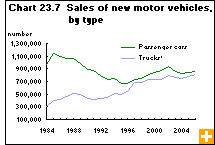Common menu bar links
Autos driving Canada’s economy
Archived Content
Information identified as archived is provided for reference, research or recordkeeping purposes. It is not subject to the Government of Canada Web Standards and has not been altered or updated since it was archived. Please contact us to request a format other than those available.
The auto industry is one that drives the Canadian economy. It is concentrated in Ontario, and is vital to the province’s economy. Auto manufacturing employs 42,000 people in Ontario, comprises 24% of all sales of manufactured goods and drives other industries, such as automotive parts.
Over the past 30 years, the automotive sector has had its ups and downs, thanks to factors such as changes in what consumers demand, more competition from countries outside North America, and an oversupply of certain models. Energy-conscious consumers are also reassessing their need for large vehicles, so demand for SUVs and other gas-guzzlers has fallen off in North America. In 2005, layoffs, temporary shutdowns of assembly lines and permanent plant closures hit the industry.
All three North American automakers—General Motors, Ford and DaimlerChrysler—have lost retail sales because of competition from innovative, foreign-owned automakers. In 2005, these three companies accounted for 75% of Canadian auto assembly, down from 85% just five years earlier.
Nevertheless, Canadians continued to buy trucks and SUVs in increasing numbers in 2005. Truck sales were especially high in Alberta, and remained strong in British Columbia and Ontario and Quebec.
The good news for the industry is that auto manufacturing in Canada may be revving up. Several of the world’s biggest players have announced billions of dollars in new investment in Canada over the next few years, and many car manufacturers are re-engineering their product lines to meet changing consumer demand.



